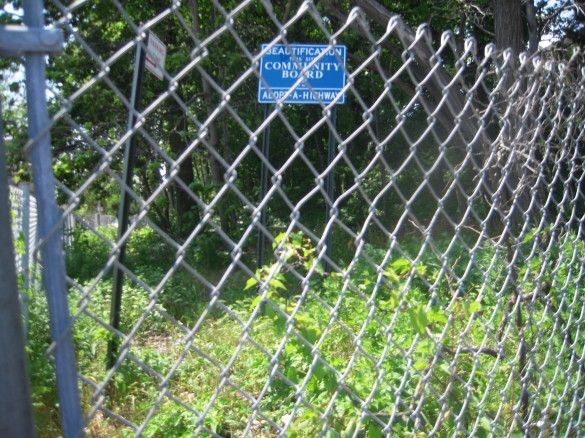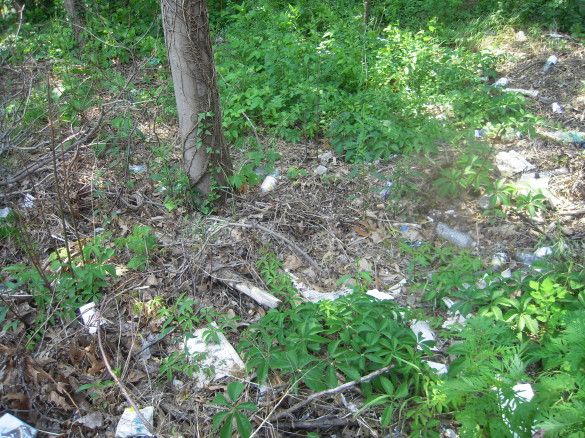A Shonda — A Look At The Adopt-A-Highway Program

THE COMMUTE: For those who don’t know Yiddish, a “shonda” means a crying shame. That’s the only way I can think of describing the above picture showing an Adopt-A-Highway segment strewn with weeds and litter. It puts the New York City Department of Transportation (NYCDOT) and Community Board 15 (CB 15) to shame, although I doubt that the community board is at fault. I could only wonder that if this is a highway beautification zone, how high would the weeds be and how much more litter would have accumulated if CB 15 had not paid to have this site “beautified.”
What does this sign mean anyway? That the upkeep for maintaining this area is paid for by CB 15? Or, did the board agree to maintain the site periodically by using volunteers? An unlikely option. I decided to do an internet investigation to find out what Adopt-A-Highway really means? I thought it provides extra cleaning support for highway sections, which local groups and businesses want to keep especially clean.
As with most research, there are no simple answers. Using Google, searching for “Adopt-A-Highway for New York City” yields conflicting information. The NYCDOT website states:
“The Adopt-A-Highway program is a tax-deductible opportunity for proud New Yorkers to give back to their community by ensuring clean and beautiful roadways in the New York City area.
Highway (sic) can be adopted by individuals, companies, or organizations (but not political candidates and campaigns). Segments can also be adopted in memory of an individual. Signs acknowledging the sponsor will be placed on the adopted roadway segment; however, the Adopt-A-Highway Program is not a forum for advertising or public discourse.
Adopting a highway is an easy way to make a visible impact on your community and show your pride in being a New Yorker.”

The signs pictured on their website include the words “Litter Removal.” However, the sign near Sheepshead Bay Road off the Belt Parkway states “Beautification of This Site,” not “Litter Removal.” So what is actually promised? Does anyone know? ”Beautification” is not defined on any of the Adopt-A-Highway internet sites I visited. One would think that a beautification service would, in fact, be higher than one only promising litter removal and would also include weed removal and flower planting perhaps. Neither is the case here.
The neighboring beautification area around the corner sponsored by the Bay Improvement Group (BIG) does include flower planting and seems to be better maintained. (I know BIG organizes groups of volunteers to periodically clean the site and plant daffodils.)
Who Is Actually Paid To Clean The Roadways, And How Often?
Again, no easy answers. The FAQ section on the website, sponsored by Litter Removal Service of America (responsible for the national program) says that Adopt-A-Highway means that volunteers two to four times per year are responsible for cleaning Adopt-A-Highway roads. There is another program called Sponsor-A-Highway, in which businesses pay them a monthly fee to clean the segments once or twice per month. The company provides the signage for both programs.
The company boasts that one of the program’s benefits is the increased frequency of litter removal at no cost to government or toll authorities. Tell that to New Jersey, which pulled out of the program in 2008 to save $100,000 per year. That amount is one person’s salary and the cost of signs [Ed. – I wish even one third of that were my salary]. Sounds penny-wise and pound-foolish since the cost to provide the same amount of cleanliness using volunteers would cost much more if performed by paid employees.
The Litter Removal Service of America boasts: “In 2012, our Clean Team crew cleaned up 127,268 bags of trash from US highways.” I guess that should sound like a lot of trash for the supposed 15 states the program covers. Actually, it is quite a meaningless number since we do not know how many miles of highway are covered.
As I stated last week, you can use statistics to show anything you want; in this case, you can show that “a lot” of litter is picked up. (I said “supposed 15 states” because they still include New Jersey who hasn’t participated since 2008.)
Okay, so if the Litter Removal Service of America is paid to pick up the trash under the Sponsor-A-Highway program and volunteers are responsible for Adopt-A-Highway segments, who is responsible for the dirty conditions near Sheepshead Bay Road? It sounds like CB 15 is at fault for not providing enough volunteers on a timely basis, according to the information provided on their site.
Wikipedia
According to Wikipedia, the distinction between Adopt-A-Highway and Sponsor-A-Highway is not distinct at all. That site states:
“In New York City, the Adopt-A-Highway program has many commercial companies renting out signs for advertisement purposes on both Highways and Parkways. Signs are rented for a term of 1 year and usually consist of about 1 mile of roadway per sign. While rented, the program then uses some of the revenue produced to have a crew come in and clean the roadway only within the renters area. Two types of crews currently clean the roadways. The picking crew removes trash from the side of the road in the grassy areas and a sweeping crew cleans dirt in the actual roadway.”
Wikipedia also discusses controversies, such as when the KKK and the American Nazi Party tried to sponsor highways, which is an interesting read.
One of those paid companies renting out signs in exchange for providing cleaning services is the Adopt-A- Highway Maintenance Corporation. They tout benefits to businesses for sponsoring highways. They say nothing about benefits to the community. Could that be because they rarely clean the roads anyway? Their FAQ section does not state how often they provide cleaning services.
So, unless CB 15 agreed to provide volunteers, AHMC is responsible for keeping the section of highway “beautified,” assuming CB 15 rented the sign from them. Then AHMC has certainly dropped the ball here.
Mass Transit
As we all know, most subway stations appear not to have been painted in decades, something Joe Lhota was looking to change. In 2007, Second Avenue Sagas asked why the MTA couldn’t have an Adopt-A-Station program. Presumably, local businesses and corporations could chip in to get some stations painted more often. This could work in wealthier neighborhoods. I recently visited the 68th Street Hunter College Station, which looks as if it has not received a paint job since I graduated Hunter in 1971. Could it work? Yes, if the MTA really cares about improving the conditions of the subway stations.
Conclusion
I wouldn’t hold my breath if an Adopt-A-Station program is administered like the NYCDOT manages its Adopt-A-Highway program because, as they state on their website, “Adopting a highway is an easy way to make a visible impact on your community and show your pride in being a New Yorker.”
Yes, those pictures of Sheepshead Bay Road sure make a visible impact and show pride. Shame on you NYCDOT.
The Commute is a weekly feature highlighting news and information about the city’s mass transit system and transportation infrastructure. It is written by Allan Rosen, a Manhattan Beach resident and former Director of MTA / NYC Transit Bus Planning (1981).
Disclaimer: The above is an opinion column and may not represent the thoughts or position of Sheepshead Bites. Based upon their expertise in their respective fields, our columnists are responsible for fact-checking their own work, and their submissions are edited only for length, grammar and clarity. If you would like to submit an opinion piece or become a regularly featured contributor, please e-mail nberke [at] sheepsheadbites [dot] com.




